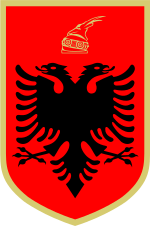Albanoi
The Albanoi (Ancient Greek: Ἀλβανοί, Albanoi; Albanian: Albanët) or Albani were an Illyrian tribe whose first historical account appears in a work of Ptolemy in addition to a town called Albanopolis (Ἀλβανόπολις) located east of the Ionian sea, in modern-day Albania.[1]

History
Ptolemy's mention in 150 AD places them in the Roman province of Macedon, specifically in Epirus Nova, almost 300 years after the Roman conquest of the region.[2] Ptolemy himself makes no hint of their true ethnic identification, and he does not clarify whether the citizens of Albanopolis were Illyrians, Macedonians or Thracians, all of which are distinct possibilities. However, from the names of places with which Albanopolis is connected, it appears clearly to have been in the southern part of the Illyrian territory, and in the center of modern Albania, an area inhabited by the Illyrians at the time.[3]
It is believed that they are related to the modern nation of the Albanians.[4] While it has been identified with the Zgërdhesh hill-fort near Krujë in northern Albania, scholars believe the Illyrian settlement here seems to have been founded in the 7th or 6th century BC and flourished in the 4th and 3rd centuries, before being abandoned in the 2nd century BC, when the inhabitants moved to Durrës and Lezhë.[5]
The first mention of Albanopolis in an inscription is on an ancient funerary stele at Scupi (near modern Skopje).[6]
Albanoi (Αλβανοι) were later mentioned in the History of Michael Attaliates around AD 1080.[7] The revolt of the Albanoi against Constantinople also dates the first written mention in Byzantine history, that refers to Albanians in an ethnic sense, around 1078, by the same Attaliates.[8]
The much later mentioned Arbanon is likely to be the name of a district – the plain of the Mat has been suggested – rather than a particular place. An indication of movement from higher altitudes in a much earlier period has been detected in the distribution of place names ending in -esh, that appears to derive from the Latin -ensis (Vulgar Latin -ēsis), between the Shkumbin and the Mat rivers, with a concentration between Elbasan and Krujë. It is not certain if the ancient city of Albanopolis corresponds with the Arbanon of the 11th century AD, mentioned by the Byzantines nine centuries later.[9]
See also
References
- Sir William Smith (1857). Dictionary of Greek and Roman Geography: Iabadius-Zymethus. Little, Brown and Co. p. 37. Retrieved 2013-03-07.
Ptolemy is the earliest writer in whose works the name of these Albanians has been distinctly recognised. He mentions (iii. 3.13.23) the name ALBANI (Ἀλβανοί) and a town ALBANOPOLIS (Ἀλβανόπολις), in the region lying to the E. of the Ionian sea; and from the names of places with which Albanopolis is connected, it appears clearly to have been in the S. part of the Illyrian territory, and in modern Albania. There is no means of forming a conjecture on how the name of this obscure tribe came to be extended to so considerable a nation.
- Richard Talbert, Barrington Atlas of the Greek and Roman World, (ISBN 0-691-03169-X), Map 49 & notes.
- Dictionary of Greek and Roman Geography (1854)William Smith, LLD, Ed., Ptolemy is the earliest writer in whose works the name of the Albanians has been distinctly recognised. He mentions (3.13.23) a tribe called ALBANI (Ἀλβανοί) and a town ALBANOPOLIS (Ἀλβανόπολις), in the region lying to the E. of the Ionian sea; and from the names of places with which Albanopolis is connected, it appears clearly to have been in the S. part of the Illyrian territory, and in modern Albania. There are no means of forming a conjecture how the name of this obscure tribe came to be extended to so considerable a nation.
- Georgiev, Vladimir (1960). "The genesis of the Balkan Peoples". The Slavonic and East European Review. 44 (103): 285–297.
- Robert Elsie (2010), Historical Dictionary of Albania, Historical Dictionaries of Europe, 75 (2 ed.), Scarecrow Press, pp. 497–498, ISBN 978-0810861886
- Bulletin analytique d'histoire romaine. Association pour l'étude de la civilisation romaine. 1974. p. 1325.
Une stèle funéraire de Scupi porte, avec la première mention épigraphique d'Albanopolis
. - Attaliates, Michael. History. Op. cit. in Elsie, Robert. The Albanian Lexicon of Dion Von Kirkman, pp. 113–122.
- The wars of the Balkan Peninsula: their medieval origins G - Reference, Information and Interdisciplinary Subjects Series Authors Alexandru Madgearu, Martin Gordon Editor Martin Gordon Translated by Alexandru Madgearu Edition illustrated Publisher Scarecrow Press, 2008 ISBN 0-8108-5846-0, ISBN 978-0-8108-5846-6 It was supposed that those Albanoi from 1042 were Normans from Sicily, called by an archaic name (the Albanoi were an ancient tribe from Southern Italy). The following instance is indisputable. It comes from the same Attaliates, who wrote that the Albanians (Arbanitai) were involved in the 1078 rebellion of... p. 25
- J. J. Wilkes, The Illyrians, 1992, ISBN 0-631-19807-5, p. 279: "We cannot be certain that the Arbanon of Anna Comnena is the same as Albanopolis of the Albani, a place located on the map of Ptolemy"
